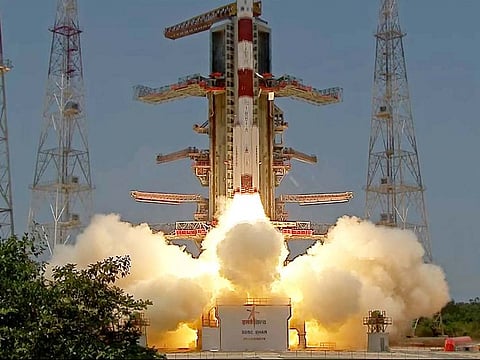Aditya-L1: After the moon, India launches rocket to study the sun
The Aditya-L1 spacecraft is designed to travel about 1.5m kms over 4 months

Bengaluru: Following quickly on the success of India's moon landing, the country's space agency launched a rocket on Saturday to study the sun in its first such solar mission.
The rocket left a trail of smoke and fire as scientists clapped, a live broadcast on the Indian Space Research Organisation's (ISRO) website showed.
India's space agency on social media platform X, formerly Twitter, later said the satellite was now in orbit.
The broadcast was watched by more than 860,000 viewers, while thousands gathered at a viewing gallery near the launch site to see the lift-off of the probe, which aims to study solar winds which can cause disturbance on earth commonly seen as auroras.
Named after the Hindi word for the sun, the Aditya-L1 spacecraft took flight barely a week after India beat Russia to become the first country to land on the south pole of the moon.
While Russia had a more powerful rocket, India's Chandrayaan-3 out-endured the Luna-25 to execute a textbook landing.
Prime Minister Narendra Modi is pushing for India's space missions to play a larger role on a world stage dominated by the United States and China. Home Affairs Minister Amit Shah, on social media platform X, said the launch was a "giant step" towards Modi's vision.
The Aditya-L1 is designed to travel 1.5 million km (930,000 miles) over four months, far short of the sun, which is 150 million km from earth. It is meant to stop its journey in a kind of parking lot in space, called a Lagrange Point, where objects tend to stay put because of balancing gravitational forces, reducing fuel consumption for the spacecraft.
"We have made sure we will have a unique data set that is not currently available from any other mission," said Sankar Subramanian, principal scientist of the mission.
"This will allow us to understand the sun, its dynamics as well as the inner heliosphere, which is an important element for current-day technology, as well as space-weather aspects," he added.
Modi congratulates scientists
Prime Minister Narendra Modi congratulated the scientists at ISRO for the successful launch of India's solar mission Aditya-L1, saying the tireless scientific efforts will continue in order to develop better understanding of the Universe for the welfare of entire humanity.
"After the success of Chandrayaan-3, India continues its space journey. Congratulations to our scientists and engineers at ISRO for the successful launch of India’s first Solar Mission, Aditya -L1," the Prime Minister posted in X, formerly known as Twitter.
"Our tireless scientific efforts will continue in order to develop a better understanding of the Universe for the welfare of humanity," he said.
A very important project
The mission also has the capacity to make a "big bang in terms of science," said Somak Raychaudhury, who was involved in developing some components of the observatory, adding that energy particles emitted by the sun can hit satellites that control communications on earth.
"There have been episodes when major communications have gone down because a satellite has been hit by a big corona emission. Satellites in low earth orbit are the main focus of global private players, which makes the Aditya-L1 mission a very important project," he said.
Scientists hope to learn more about the effect of solar radiation on the thousands of satellites in orbit, a number growing with the success of ventures like the Starlink communications network of Elon Musk's SpaceX.
"The low earth orbit has been heavily polluted due to private participation, so understanding how to safeguard satellites there will have special importance in today's space environment," said Rama Rao Nidamanuri, head of the department of earth and space sciences at the Indian Institute of Space Science and Technology.
Longer term, data from the mission could help better understand the sun's impact on earth's climate patterns and the origins of solar wind, the stream of particles that flow from the sun through the solar system, ISRO scientists have said.
Pushed by Modi, India has privatised space launches and is looking to open the sector to foreign investment as it targets a five-fold increase in its share of the global launch market within the next decade.
As space turns into a global business, the country is also banking on the success of ISRO to showcase its prowess in the sector.
Budget programme
India has been steadily matching the achievements of established spacefaring powers at a fraction of their cost. The South Asian nation has a comparatively low-budget space programme, but one that has grown considerably in size and momentum since it first sent a probe to orbit the Moon in 2008. Experts say India can keep costs low by copying and adapting existing technology, and thanks to an abundance of highly skilled engineers who earn a fraction of their foreign counterparts' wages. Last month's successful landing on the lunar surface - a feat previously achieved only by Russia, the United States and China - cost less than $75 million. The touchdown was widely celebrated by the public, with prayer rituals to wish for the mission's success and schoolchildren following its final descent from live broadcasts in classrooms. India became the first Asian nation to put a craft into orbit around Mars in 2014 and is slated to launch a three-day crewed mission into the Earth's orbit by next year. It also plans a joint mission with Japan to send another probe to the Moon by 2025 and an orbital mission to Venus within the next two years.
Sign up for the Daily Briefing
Get the latest news and updates straight to your inbox





